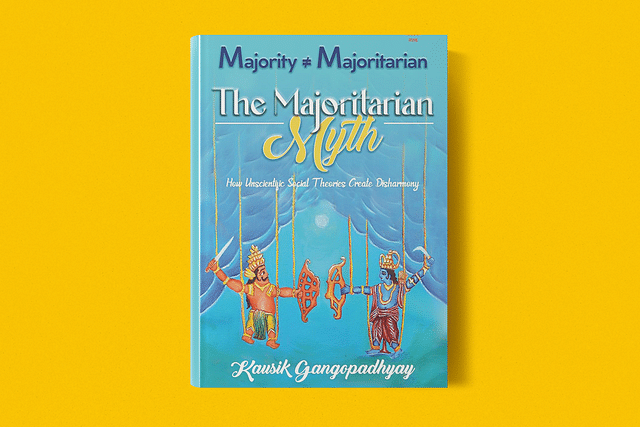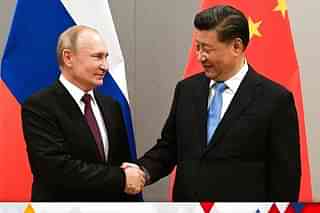Books
Is Dharmic India Majoritarian? New Book Debunks Faulty Social Theory
R Jagannathan
Mar 18, 2024, 01:13 PM | Updated 01:13 PM IST
Save & read from anywhere!
Bookmark stories for easy access on any device or the Swarajya app.

The Majoritarian Myth: How Unscientific Social Theories Create Disharmony. Kausik Gangopadhyay. Garuda Prakashan. 2024. Pages 329. Price Rs 449.
* Some time in 2011, the UPA government had before it a draft bill titled Prevention of Communal and Targeted Violence (Access to Justice and Reparations) Bill.
The bill never saw the light of day, thanks largely to strong pushbacks from states that saw their own law and order powers being curtailed by the Centre.
But the real problem was how it defined targeted groups as “a religious or linguistic minority, in any state in the Union of India, or Scheduled Castes and Scheduled Tribes (SC/ST)….”. In other words, only the “minorities” can be targeted.
* Towards the end of 2014 and a few weeks into 2015, just a few months after Narendra Modi came to power with a clear majority, a few random incidents in some Delhi’s churches quickly became a 'secular' concern and were dubbed as attacks on Christians in general.
The police investigated these incidents and pointed out that similar instances had occurred in more than 250 temples, gurudwaras, and mosques. There was no particular pattern to the incidents involving churches.
* In September 2015, the lynching of Mohammed Akhlaq in Uttar Pradesh’s Dadri district for allegedly slaughtering a cow drew headlines nationally and internationally.
The case led to the labelling of India as “lynchistan”, where the majority community routinely targeted the minorities. But just a few months earlier, in March 2015, the lynching of Syed Sarifuddin Khan in Dimapur, Nagaland, drew no such descriptions. It was put down to ethnic tensions driven by illegal immigration.
In Nagaland, which is overwhelmingly Baptist Christian, the lynching of the Muslim citizen was motivated by revenge for an alleged rape of a Naga girl earlier by Sarifuddin Khan.
Unlike the Dadri incident later, the person lynched in Dimapur had actually been jailed, but the mob broke the jail open, dragged him out, paraded him naked, and thrashed him to death. And yet, nobody drew any hasty conclusions about the religious affiliations of the mob that did the killing.
What is common to these three exhibits above is the general assumption in media and influential circles that the majority Hindu community is the culprit.
These acts of violence were the result of “majoritarianism” — a phrase we hear repeatedly in the mainstream Indian and international media — where a numerically dominant majority is presumed to oppress the minority/ies.
In this scheme of thinking, the minorities are to be given a free pass even if they are actually guilty of violence against the majority just because they are the minority. The majority will be deemed guilty unless proven innocent, and even then innocence will not be admitted.
A brilliant new book by Kausik Gangopadhyay, a professor with the Indian Institute of Management, Kozhikode, explains the dubious premises of majoritarianism in a book.
The book, titled, The Majoritarian Myth: How Unscientific Social Theories Create Disharmony, is a must read for Western scholars and media mavens who routinely castigate the majority for being oppressive not only in India, but in their own countries as well.
Thus, in the USA, if you are white, you are presumed guilty of subliminal racial prejudice even if you do not have a mean bone in your body. In India, if you are Hindu, ipso facto you are presumed to be capable of being anti-Muslim or anti-Christian, never mind the evidence.
Gangopadhyay’s theory is simple: social intolerance is not necessarily a function of numerical majorities, but of ideologies that are driven by belief in a Linear Theory of Social Evolution, or LTSE.
Believers in LTSE rigidly hold on to two things: one, no matter what the evidence or social experience, their plan to 'improve society' and make it perfect cannot be changed. And two, believers in LTSE have to be willing to discriminate against the disbelievers.
Modern-day Left-liberals, who dominate academics, are essentially extreme believers in LTSE, and hence cannot by any stretch be called liberals.
LTSE thinking clearly has its origins in Abrahamic religions, especially political Christianity (before the enlightenment) and political Islam (still rampant), and evolved further under Marxist tutelage.
But after the failure of the first socialist states under Lenin and Stalin, and national socialism under Adolf Hitler, the new Marxists adopted a new maxim that called for a war against dominant cultures. Culture became the new war zone.
Antonio Gramsci, an Italian communist who spent a large part of his life in jail, is the father of modern-day LTSE thinking among Left-Liberals.
As opposed to the LTSE, whose believers necessarily have to use violence and power to enforce their vision on the unwilling, there is the Dharmic way with its cyclical theory of evolution, where evidence and experience, and ideals of satya and ahimsa, impact social evolution.
Thomal Sowell, American economist, social philosopher and political commentator, has a different way of describing what Gangopadhyay says with the concept of LTSE. In the Vision of the Anointed, he says that the true purpose of the Left-liberal do-gooders is not necessarily to improve society, but to feel good about themselves, which gives them moral and intellectual superiority over the rest.
This is why they seek overwhelming state power to subjugate the 'benighted', those who believe that not all of social problems are necessarily solvable by government action. What is clear is that Left-liberal ideologues want power in the name of doing what is right, never mind whether their plans work or not. Their LTSE vision justifies the means used to achieve social change.
Gangopadhyay points out that LTSE’s unfalsifiable propositions are essentially unscientific. Belief is the only thing needed. In contrast, it should be possible to prove that the concept of majoritarianism is flawed if only some societies exhibit tendencies of LTSE thinking while others don’t.
One test he suggests is this: in LTSE societies, minorities could be shrinking under the pressure of majoritarianism, but in non-LTSE societies, there should be minimal impact. From Nazi Germany to Stalinist Soviet Union to Islamist countries, LTSE societies have eliminated or decimated those who disagreed with them.
In a non-LTSE society like India, the minority religions have actually expanded — except in that segment of society where LTSE thinking prevails (Muslim-majority Kashmir, for example, where the Pandits were ethnically cleansed).
Gangopadhyay has brought great clarity to the idea of majoritarianism, and illustrated the difference between assuming that all majorities everywhere can be oppressive based only on experiences in Western culture.
Even in Western culture, where enlightenment values have dethroned old-style Christian LTSE thinking, the only form of majoritarian thinking that survives is in the Left-liberal academic and intellectual sphere.
The next time you use the term majoritarian, think twice about whether you are referring to just a numerical majority, or a majority with LTSE characteristics.
Save & read from anywhere!
Bookmark stories for easy access on any device or the Swarajya app.
Jagannathan is Editorial Director, Swarajya. He tweets at @TheJaggi.
Support Swarajya's 50 Ground Reports Project & Sponsor A Story
Every general election Swarajya does a 50 ground reports project.
Aimed only at serious readers and those who appreciate the nuances of political undercurrents, the project provides a sense of India's electoral landscape. As you know, these reports are produced after considerable investment of travel, time and effort on the ground.
This time too we've kicked off the project in style and have covered over 30 constituencies already. If you're someone who appreciates such work and have enjoyed our coverage please consider sponsoring a ground report for just Rs 2999 to Rs 19,999 - it goes a long way in helping us produce more quality reportage.
You can also back this project by becoming a subscriber for as little as Rs 999 - so do click on this links and choose a plan that suits you and back us.
Click below to contribute.





